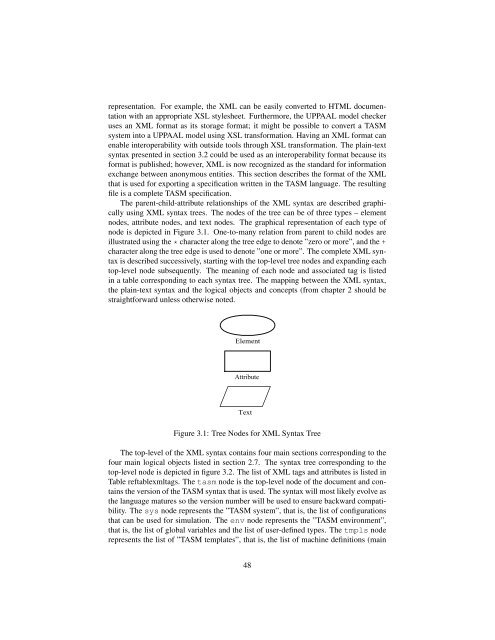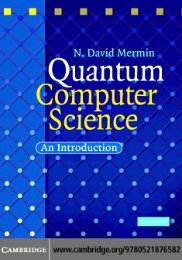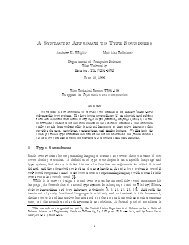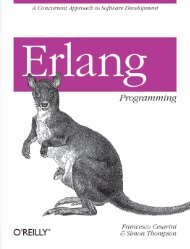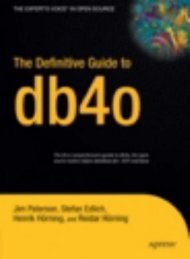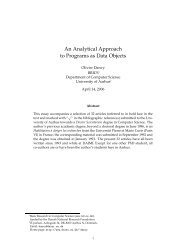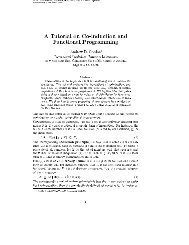The TASM Language Reference Manual Version 1.1 - Synrc
The TASM Language Reference Manual Version 1.1 - Synrc
The TASM Language Reference Manual Version 1.1 - Synrc
Create successful ePaper yourself
Turn your PDF publications into a flip-book with our unique Google optimized e-Paper software.
epresentation. For example, the XML can be easily converted to HTML documentation<br />
with an appropriate XSL stylesheet. Furthermore, the UPPAAL model checker<br />
uses an XML format as its storage format; it might be possible to convert a <strong>TASM</strong><br />
system into a UPPAAL model using XSL transformation. Having an XML format can<br />
enable interoperability with outside tools through XSL transformation. <strong>The</strong> plain-text<br />
syntax presented in section 3.2 could be used as an interoperability format because its<br />
format is published; however, XML is now recognized as the standard for information<br />
exchange between anonymous entities. This section describes the format of the XML<br />
that is used for exporting a specification written in the <strong>TASM</strong> language. <strong>The</strong> resulting<br />
file is a complete <strong>TASM</strong> specification.<br />
<strong>The</strong> parent-child-attribute relationships of the XML syntax are described graphically<br />
using XML syntax trees. <strong>The</strong> nodes of the tree can be of three types – element<br />
nodes, attribute nodes, and text nodes. <strong>The</strong> graphical representation of each type of<br />
node is depicted in Figure 3.1. One-to-many relation from parent to child nodes are<br />
illustrated using the * character along the tree edge to denote ”zero or more”, and the +<br />
character along the tree edge is used to denote ”one or more”. <strong>The</strong> complete XML syntax<br />
is described successively, starting with the top-level tree nodes and expanding each<br />
top-level node subsequently. <strong>The</strong> meaning of each node and associated tag is listed<br />
in a table corresponding to each syntax tree. <strong>The</strong> mapping between the XML syntax,<br />
the plain-text syntax and the logical objects and concepts (from chapter 2 should be<br />
straightforward unless otherwise noted.<br />
Element<br />
Attribute<br />
Text<br />
Figure 3.1: Tree Nodes for XML Syntax Tree<br />
<strong>The</strong> top-level of the XML syntax contains four main sections corresponding to the<br />
four main logical objects listed in section 2.7. <strong>The</strong> syntax tree corresponding to the<br />
top-level node is depicted in figure 3.2. <strong>The</strong> list of XML tags and attributes is listed in<br />
Table reftablexmltags. <strong>The</strong> tasm node is the top-level node of the document and contains<br />
the version of the <strong>TASM</strong> syntax that is used. <strong>The</strong> syntax will most likely evolve as<br />
the language matures so the version number will be used to ensure backward compatibility.<br />
<strong>The</strong> sys node represents the ”<strong>TASM</strong> system”, that is, the list of configurations<br />
that can be used for simulation. <strong>The</strong> env node represents the ”<strong>TASM</strong> environment”,<br />
that is, the list of global variables and the list of user-defined types. <strong>The</strong> tmpls node<br />
represents the list of ”<strong>TASM</strong> templates”, that is, the list of machine definitions (main<br />
48


